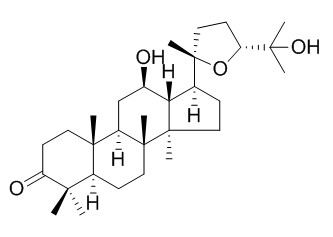20S,24R-Epoxydammar-12,25-diol-3-one
Reference standards.
Inquire / Order:
manager@chemfaces.com
Technical Inquiries:
service@chemfaces.com
Tel:
+86-27-84237783
Fax:
+86-27-84254680
Address:
1 Building, No. 83, CheCheng Rd., Wuhan Economic and Technological Development Zone, Wuhan, Hubei 430056, PRC
Providing storage is as stated on the product vial and the vial is kept tightly sealed, the product can be stored for up to
24 months(2-8C).
Wherever possible, you should prepare and use solutions on the same day. However, if you need to make up stock solutions in advance, we recommend that you store the solution as aliquots in tightly sealed vials at -20C. Generally, these will be useable for up to two weeks. Before use, and prior to opening the vial we recommend that you allow your product to equilibrate to room temperature for at least 1 hour.
Need more advice on solubility, usage and handling? Please email to: service@chemfaces.com
The packaging of the product may have turned upside down during transportation, resulting in the natural compounds adhering to the neck or cap of the vial. take the vial out of its packaging and gently shake to let the compounds fall to the bottom of the vial. for liquid products, centrifuge at 200-500 RPM to gather the liquid at the bottom of the vial. try to avoid loss or contamination during handling.
Chem Biodivers.2023, 20(12):e202301461.
Natural Product Communications2020, doi: 10.1177.
Arch Biochem Biophys.2018, 644:93-99
Dent Mater J.2020, 39(4):690-695
Saudi Pharm J2020, 10.1016
J Biol Chem.2014, 289(3):1723-31
Nutrients2022, 14(3),695.
Applied Biological Chemistry2022, 65(85).
J Food Biochem.2019, 43(9):e12970
Metabolites2022, 12(6),507.
Related and Featured Products
Drug Metab Dispos. 2011 Mar;39(3):472-83.
Identification of 20(S)-protopanaxadiol metabolites in human liver microsomes and human hepatocytes.[Pubmed:
21139039]
20(S)-Protopanaxadiol (PPD, 1) is one of the aglycones of the ginsenosides and has a wide range of pharmacological activities. At present, PPD has progressed to early clinical trials as an antidepressant.
CONCLUSIONS:
In this study, its fate in mixed human liver microsomes (HLMs) and human hepatocytes was examined for the first time. By using liquid chromatography-electrospray ionization ion trap mass spectrometry, 24 metabolites were found. Four metabolites were isolated, and their structures were elucidated as (20S,24S)-epoxydammarane-3,12,25-triol (2), (20S,24R)-epoxydammarane-3,12,25-triol (3), (20S,24S)-epoxydammarane-12,25-diol-3-one (4), and (20S,24R)-epoxydammarane-12,25-diol-3-one (5) based on a detailed analysis of their spectroscopic data. The predominant metabolic pathway of PPD observed was the oxidation of the 24,25-double bond to yield 24,25-epoxides, followed by hydrolysis and rearrangement to form the corresponding 24,25-vicinal diol derivatives (M6) and the 20,24-oxide form (2 and 3). Further sequential metabolites (M2-M5) were also detected through the hydroxylation and dehydrogenation of 2 and 3. All of the phase I metabolites except for M1-1 possess a hydroxyl group at C-25 of the side chain, which was newly formed by biotransformation. Two glucuronide conjugates (M7) attributed to 2 and 3 were detected in human hepatocyte incubations, and their conjugation sites were tentatively assigned to the 25-hydroxyl group.
CONCLUSIONS:
The findings of this study strongly suggested that the formation of the 25-hydroxyl group is very important for the elimination of PPD.



